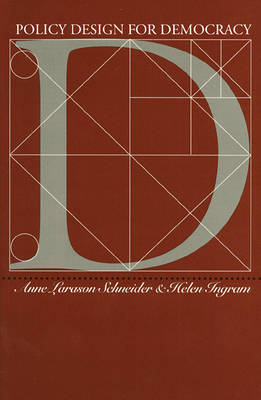
- Afhalen na 1 uur in een winkel met voorraad
- Gratis thuislevering in België vanaf € 30
- Ruim aanbod met 7 miljoen producten
- Afhalen na 1 uur in een winkel met voorraad
- Gratis thuislevering in België vanaf € 30
- Ruim aanbod met 7 miljoen producten
Zoeken
Omschrijving
How can democracy be improved in an age when people are profoundly disenchanted with government? Part of the answer lies in the design of public policy that unmistakenly works to advance citizenship by listening to, educating, and involving ordinary people. Rather than serve mainly the narrow interests of powerful groups who are socially constructed as "deserving" or issuing discipline and punishment to powerless people socially constructed as "undeserving," public policy needs to advance citizenship, solve problems, pursue justice, and balance the interests of individuals with a concern for the collective good. Policy Design for Democracy is a theoretically sophisticated work that draws examples from a wide array of public policy arenas. It summarizes four current approaches to policy theory-pluralism, policy sciences, public choice, and critical theory-and shows how none offers more than a partial view of the policy design characteristics that support and perpetuate democracy. Schneider and Ingram then develop a theory of public policymaking predicated on understanding how differences in policy designs are related to differences in the contexts from which they emerge and how these designs have an impact on democracy. One of the first books to examine systematically the substantive aspects of public policy, Policy Design for Democracy is written clearly and with sufficient examples to make it easily understandable by undergraduates. Its linkage of public policy to citizenship is an important antidote to the overly technical and goal-driven orientation adopted by the policy sciences and public choice, and to the overly self-interested and strategic political games found in pluralist theory. Schneider and Ingram close by recommending a series of reforms that will improve policy designs and help restore citizen confidence in government.
Specificaties
Betrokkenen
- Auteur(s):
- Uitgeverij:
Inhoud
- Aantal bladzijden:
- 256
- Taal:
- Engels
- Reeks:
Eigenschappen
- Productcode (EAN):
- 9780700608430
- Verschijningsdatum:
- 8/09/1997
- Uitvoering:
- Hardcover
- Formaat:
- Genaaid
- Afmetingen:
- 160 mm x 240 mm
- Gewicht:
- 576 g

Alleen bij Standaard Boekhandel
+ 169 punten op je klantenkaart van Standaard Boekhandel
Beoordelingen
We publiceren alleen reviews die voldoen aan de voorwaarden voor reviews. Bekijk onze voorwaarden voor reviews.











